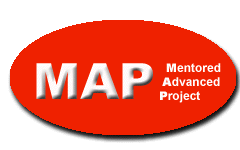
Outcomes
of MAP Assessment
2001 - 2002
MAP Assessment Materials Discussed by Curriculum Committee
Final
Curriculum Committee Report to the Executive Council
Curriculum Committee Criteria:
Degree of participation of students, faculty, and departments
Do MAPs satisfy the original desires of the proposed experiment?
Degree of satisfaction on the part of faculty members involved with Maps
Degree of satisfaction on the part of students who have completed Maps
Maps vs. other similar curricular elements of the college
Working definition of MAP
a. What is the degree of participation of students, faculty, and departments with MAPs?
Source: Records from the Office of the Associate Deans
As of fall 2001, 93 of 133 faculty members (70%) have directed at least one MAP, 302 students have enrolled for at least one MAP, and all but four academic departments have participated in the MAP program. The majority of MAPs take place in the summer, and most of these are in the science division. However, all divisions are well represented. At the end of summer 2001, 48 MAPs had been completed in Humanities departments, 73 in Social Studies departments, 183 in Science departments, 16 in interdisciplinary concentrations, 30 with divisional designators, and 3 as senior projects for an Independent Major. Of the 93 faculty members who have directed one or more MAPs, 22 are in the Humanities division, 44 in the Science division, and 27 in Social Studies.
b. Do the current MAPs satisfy the original desires of the proposed experiment?
Sources: October 1998 FFE Proposal on Mentored Independent Learning (entire proposal. For Part 4: MAP Excerpt, click here) and Faculty MAP Initiative Endorsed in April 2000.
The 1998 FFE proposal called for MAPs as a means to encourage students to strive for higher levels of academic achievement; to enhance opportunities for students to engage in advanced work in either a department or an interdisciplinary area; to help students focus and integrate the upper level of their academic programs; to highlight the value of research on the liberal arts campus; to compensate faculty for this important component of teaching; and to give students practice with skills that will contribute to their success after college. The 2000 proposal endorsed by the faculty called for MAPs as a means to expand existing opportunities for upper-level student work that provides a “culminating” academic experience; to encompass interdisciplinary senior seminars as an alternative MAP model; and to create a working definition of MAP that is flexible enough to describe work in any discipline but unified enough to merit a single label.
c.1. What is the degree of satisfaction on the part of faculty members involved with MAPs?
Source: Carol Trosset’s Analysis of Faculty MAP Reports
Additional information on the faculty perspective will emerge in divisional discussions.
Reports from 76 faculty members, representing 18 departments, analyze approximately 160 Mentored Advanced Projects taking place between summer 1999 and summer 2001.
Everyone who answered the question said that it provided a good academic experience for students. About two-thirds of the projects contribute directly to faculty scholarship.
Emerging themes included the widespread opinion that a MAP experience should be able to extend over a longer time than one summer or semester; that a MAP has a greater chance of success if students are well-prepared and have done extensive background research; and some faculty members do not feel that current compensation adequately reflects the commitment of time involved in directing a MAP.
c.2. What is the degree of satisfaction on the part of students who have completed MAPs?
Source: December survey of Class of ’01; Discussions in Student Curriculum Council
Alumni comments on MAPs and Capstones, Class of 2001
Source: SGA Vice President for the Student Curriculum Council
Survey Questions | Survey Results
Results of a 2001-02 survey of current students indicates that those who have carried out MAPs are overwhelmingly positive about the experience. Those who have not done a MAP are most likely to cite 'did not have a chance' or 'did not know about it' as the reason.
d. Is there a qualitative difference between MAPs and other similar curricular elements of the college?
Sources: David Lopatto Memo of September 24, 2001 on “Possible Evaluation of Mentored Projects”; FFE Proposal of October 1998; Faculty Initiative of April 2000.
David Lopatto reports that “the bottom line is that there are few differences between the students’ experiences of MAPs and nonMAPs.” The faculty-endorsed MAP initiative of April 2000 points out that “many projects that have been previously offered as four-credit Independents, four-credit summer research projects, or concentration research projects have the five features [of MAP] listed above.* But not all of this previous work would qualify, if any of the five features were lacking. What we propose, then, is not smply a grand re-naming of what we have been doing for years.” The FFE proposal described the current system of independent work as “haphazard” and pointed out that while it is radical to ask for a “major redeployment of College resources and priorities” to support MAPs, at the same time “all we are asking is to do what we are already doing, but to be given the committed resources to be able to do it right...[to] communicate what it is that makes Grinnell a unique and valuable learning environment.”
* Working Definition of MAP: The project has one or more prerequisites above the intermediate level; it culminates a sequence of previous academic work in one or more disciplines; the student shows individual initiative in delineating and carrying out the project [though it’s fine for the MAP to fit within ongoing faculty research]; it is intensively mentored by a faculty member; the project results in a product that is designed to be shared with an audience beyond the campus. Students are encouraged to submit MAP results for off-campus presentation and publication.